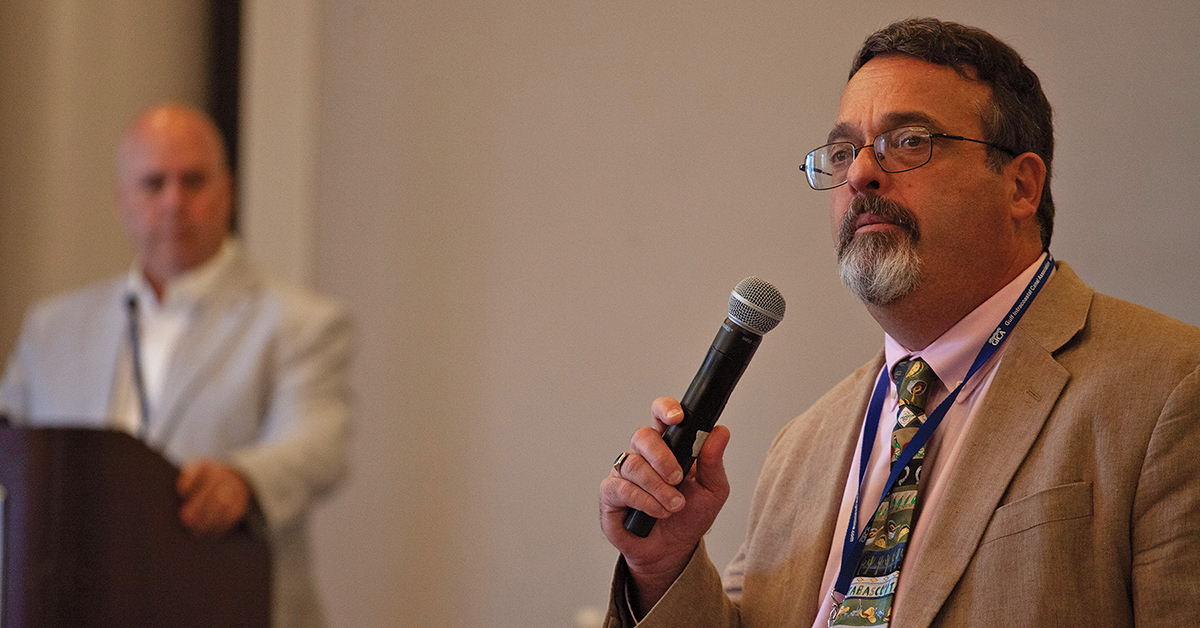Stakeholders of the Gulf Intracoastal Waterway (GIWW) will gather in New Orleans August 6–8 for the 120th annual seminar of the Gulf Intracoastal Canal Association (GICA). The GICA Seminar will be held at the Westin Canal Place where Canal Street meets the Mississippi River. Registration details and the conference agenda are available online at www.gicaonline.com.
The Waterways Journal recently interviewed GICA President Paul Dittman on the state of commercial navigation on the Gulf Intracoastal Waterway and what stakeholders can expect from the upcoming seminar.
The Waterways Journal: June 1 marked the start of the 2025 Atlantic basin hurricane season. What’s the status of the Joint Hurricane Team (JHT) Protocol? How has that proven valuable for communities and businesses along the GIWW and for users of the waterway?
Paul Dittman: The JHT Protocol has been in place since 2006 and is reviewed and updated, as needed, annually. The protocol once again proved its value during the 2024 hurricane season and was used to coordinate response and recovery efforts during multiple tropical weather events including Beryl, Milton, Helene, Debbie, Rafael and Francine. Francine, by far, was the most challenging as this storm raked the entire Gulf Coast from south Texas to Florida, impacting all six U.S. Coast Guard Captain of the Port zones and all three Corps of Engineers districts engaged in preparation and response operations.
The communications protocols crafted in 2006, honed over the following 18 years, paid huge dividends. After Francine’s landfall, the GIWW was closed from the Calcasieu Lock to the Algiers Lock, including the entire Port Allen Route. The GIWW from the Calcasieu River to the Port Allen Lock in Baton Rouge, La., is the primary umbilical to connect our nation’s petrochemical epicenters with the rest of the nation via access to the Mississippi River. As the storm was making landfall, GICA reached out to membership to identify potential test tows to run various sections of the GIWW to assess waterway conditions in anticipation of post-storm recovery operations.
Post-storm, GICA leveraged the communications procedures codified in the JHT Protocol and successfully coordinated with three different Coast Guard Captain of the Port zones to run industry-led test tows to assess over 200 miles of the GIWW from the Calcasieu Lock to the Port Allen Lock.
The joint effort reopened this vital strategic waterway in a little over 48 hours while freeing up federal channel survey assets to focus on waterways more heavily impacted by the storm. Francine epitomized the effective public–private coordination envisioned when the JHT Protocol was initially developed. The seamless coordination between government and industry stakeholders was a direct result of the legacy created by the JHT Protocol and the strong relationships GICA maintains with federal and state partners.
WJ: A lot has happened since last year’s GICA Seminar. What do you think will be on the mind of attendees of this year’s seminar? What issues will they want to discuss, or what questions will they want to ask?
PD: With a new administration comes new areas of emphasis and focus. I am confident attendees will be interested to know how the change in leadership in Washington may impact pending infrastructure projects, including the Brazos River Flood Gates and the effort to replace the Inner Harbor Navigation Canal Lock. GICA has a very strong relationship with Waterways Council Inc. (WCI), and one of the highlights of the GICA Seminar each year is WCI’s update regarding infrastructure funding and overall regulatory outlook. We will also have three new Corps district commanders in Galveston, New Orleans and Mobile this summer, and each new commander will participate in a panel discussion on Thursday afternoon. Their perspective regarding funding and infrastructure maintenance and replacement will undoubtedly be of interest. I see the seminar as a perfect opportunity for them to be able to interface with one of their most important customer bases, users of the GIWW, and to drive home the point that ‘GICA is just a phone call away.’
We have also heard the Coast Guard may be reassessing its management of Vessel Traffic Service (VTS) operations. Thus, we have a panel discussion scheduled on Thursday with all four VTS directors from New Orleans, Morgan City, Port Arthur and Houston. I am sure it will be of interest to membership.
WJ: You mentioned the Inner Harbor Navigation Canal Lock Replacement Project, which has been in the news a lot lately. What do stakeholders need to know about that part of the system and the outlook for its replacement?
PD: The need to replace this century old piece of maritime infrastructure is well known throughout the marine industry, and the Corps of Engineers has gone to great lengths to ensure all stakeholder input is thoroughly documented and considered throughout the replacement process. GICA continues to work closely with the Corps. Over the past six months, GICA coordinated outreach to both the Florida Department of Transportation and various Department of Defense logistics coordinating elements to highlight potential impacts the IHNC Lock may have on various civilian and military fuel supply chains.
GICA wants to ensure that all supply chain impacts associated with this 102-year-old lock are not overlooked by end users who may not realize the lock’s importance to their operations. That information can afford them the opportunity to provide input during the public comment process to ensure all impacts associated with the lock are formally documented for consideration moving forward.
WJ: Another issue constantly in the news is artificial intelligence and the looming impact AI could have on every aspect of life. Tell me about the session The Water Institute will host on using AI and crowdsourced data to maintain channels and terminals. What do you see as the role of technology in helping the GIWW succeed?
PD: The Water Institute’s efforts regarding the use of crowd sourcing data to maintain and enhance situational awareness of channel conditions is intriguing, to say the least. I believe we need to be open to new ideas and fully consider out-of-the-box solutions to navigation safety issues afforded by new technology. Opening dialogue and enhancing industry awareness of what is now in the realm of the possible is the first step in any effort to leverage capabilities afforded by AI and other technological advances, which just a few years ago did not exist.
WJ: American Cruise Lines will add a GIWW-based itinerary between New Orleans and Pensacola, Fla., in 2026. Can you discuss the use of the waterway for recreational boating and passenger cruising?
PD: I had the pleasure of meeting representatives from American Cruise Lines (ACL) last February during the annual WCI D.C. fly-in to engage elected officials regarding inland waterway navigation issues. I highly encouraged ACL to consider joining GICA as a potential new commercial operator on the eastern part of the canal.
The unfettered expansion of private recreational boat slips, marinas and boat launches is GICA’s primary concern regarding recreational traffic. GICA works very closely with the Corps, in particular the Mobile District, to closely assess proposed marina permit applications against historic waterway capacity study recommendations to ensure the continued safe and viable use of the GIWW for its intended purpose to support commercial navigation.
GICA is concerned uncoordinated expansion of recreational vessel activities, with no planning and forethought, will slowly induce more and more risk over time, risk which may not be clearly identified until it is too late to prevent or mitigate.
WJ: Moveable bridges are always a topic of conversation at the seminar. Can you update readers on the status of moveable bridges over the GIWW?
PD: GICA continues to coordinate very closely with the Coast Guard and various moveable bridge operators throughout the GIWW. Last October, GICA drafted a four-page letter to the commander of the Heartland District documenting, in detail, the risks posed by the Black Bayou and Grand Lake bridges near Lake Charles and the impacts these bridges may have on post-hurricane Coast Guard response operations, including search and rescue, marine environmental response and maritime transportation system recovery. Further, GICA is working closely with the Louisiana Ports and Waterways Investment Commission (LPWIC) to highlight the need for these two moveable bridges to be replaced in the future with one or more fixed bridges to mitigate risk to mariners and the local communities during tropical weather events.
One of the strengths of GICA is the ability to develop, foster and leverage relationships, in this case with moveable bridge operators. This was clear during GICA’s coordination with Union Pacific Railroad and the Coast Guard during extended repair operations involving both the Morley and Krotz Springs railroad bridges. Early and effective communication and coordination minimized the impact of the required waterway closures and channel obstructions, which greatly enhanced the safety of bridge maintenance personnel and mariners transiting the work sites.
Over 70 percent of the movable bridges along the GIWW are in Louisiana, and GICA’s relationship with the Louisiana Department of Transportation and Development has paid similar dividends during planned and emergent repairs throughout the state.
Just like hurricane response operations, it’s not knowing who to call, but knowing who you are calling. GICA maintains a first-name relationship with the LA-DOTD bridge engineers throughout the GIWW, facilitating early and effective communication.
WJ: Paul, I feel like there’s not a day that goes by that I don’t receive an update or bulletin from GICA. You’re a busy man.
PD: I feel like I’m working harder than I ever have before, but I also believe I’m having a bigger impact than ever, not just along the GIWW and for GICA members, but for the nation.
More About The Upcoming Seminar
The 120th annual GICA Seminar will open August 6 with a board of directors meeting and a welcome reception. Day two will include a welcome from GICA board chairman Patrick Morton and Dittman. Attendees will also hear from Capt. Ulysses Mullins, chief of staff for the Coast Guard’s Heartland District, and WCI President and CEO Tracy Zea. The Corps commanders’ panel, Coast Guard captain of the port panel, a towboat operators panel, a Texas Department of Transportation presentation, the VTS directors panel and the presentation from The Water Institute will all fall on August 7.
Day three of the GICA Seminar will include a GICA membership business meeting, an update on the IHNC Lock replacement project, a session on mariner health issues by the Seamen’s Church Institute and an update on the American Waterways Operators’ bridge event reporting system.
Featured image caption: GICA President Paul Dittman at the association’s 2024 seminar in New Orleans. (Photo by Frank McCormack)




